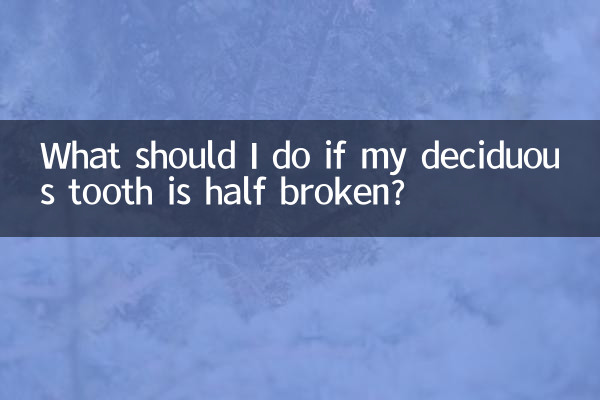What should I do if my deciduous tooth is half broken? A must-read emergency guide for parents
Fracture of children's deciduous teeth is a common accident, and how to deal with it correctly is related to the child's oral health and subsequent development. This article combines hot topics and medical advice on the Internet in the past 10 days to provide you with structured solutions.
1. Emergency treatment steps for fractured deciduous teeth

| step | Operational points | Things to note |
|---|---|---|
| 1. Calm and comfort | Soothe your child immediately | Prevent children from accidentally swallowing fragments when crying |
| 2. Clean your mouth | Rinse mouth gently with warm water | Do not brush your teeth vigorously or use a toothpick |
| 3. Save the fragment | Soak the broken tooth in saline/milk | Do not wrap in paper towels or store dry |
| 4. Hemostatic treatment | Press the bleeding area with clean gauze for 10 minutes | If bleeding continues for more than 30 minutes, seek medical attention |
| 5. Seek medical attention promptly | The golden rescue time is within 2 hours after injury | Carrying preserved tooth fragments |
2. Treatment options for different types of fractures
| Fracture type | Feature description | Professional handling advice |
|---|---|---|
| Crown fracture | Visible tooth defects, no pulp exposure | Resin restoration or preformed crown restoration |
| Pulp exposure | Red bleeding spots are visible on the cross section | Need for pulpotomy treatment |
| Root fracture | The teeth are obviously loose | May require root removal + space maintainer |
| come off completely | The whole tooth is knocked out | The highest replantation success rate within 30 minutes |
3. Frequently Asked Questions for Parents
Q1: Do broken deciduous teeth need to be replaced?
According to the latest oral medicine guidelines:
• Less than 1/3 of the defect is observable
• It is recommended to repair 1/3-1/2 of the defect
• Defects exceeding 1/2 or affecting the bite must be treated
Q2: Will it affect the development of permanent teeth?
Data shows that trauma to deciduous teeth leads to the probability of abnormal permanent teeth:
• Enamel hypoplasia 25-34%
• Abnormal development of tooth roots 15-22%
• Eruption disorders 7-13%
Timely and standardized treatment can reduce the risk
Q3: In which cases do I need to seek medical attention immediately?
• Teeth are significantly displaced or embedded
• Gums that continue to bleed
• Symptoms of infection such as fever
• Child refuses to eat for more than 24 hours
4. Five major measures to prevent deciduous teeth from breaking
1. Sports protection: It is recommended to wear a sports mouthguard when riding a bicycle/skateboard
2. Furniture modification: Install anti-collision strips on table corners. Furniture with a height of ≤50cm needs special protection.
3. Dietary precautions: Avoid chewing hard objects (such as nuts, ice cubes) directly with your front teeth.
4. Habit cultivation: correct bad habits such as biting pencils and straws
5. Regular check-ups: Perform oral check-ups every 3-6 months to detect dental caries and other hidden dangers in a timely manner
5. Latest Treatment Technology Progress
Innovations in Pediatric Dentistry in 2023:
• Bioactive material regeneration technology (success rate increased to 82%)
• Precise repair of digital guide plate (error controlled within 0.1mm)
• Painless laser treatment application (suitable for children over 3 years old)
• Absorbable restorative materials for deciduous teeth
Warm reminder: The data in this article are synthesized from the latest 2023 guidelines from authoritative organizations such as the Chinese Dental Association and the American Academy of Pediatric Dentistry. Specific treatment plans need to be determined after evaluation by a professional physician.

check the details

check the details